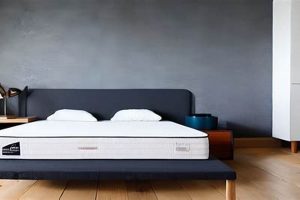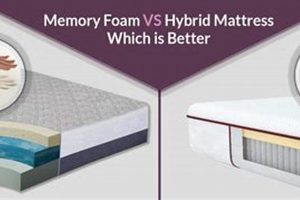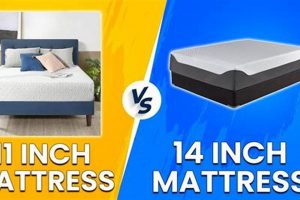A primary distinction exists between items designed to safeguard a mattress and those intended to cover it. The former serves a protective role, shielding the mattress from spills, stains, dust mites, and other potential damage. The latter primarily provides a comfortable and clean sleeping surface, contributing to hygiene and ease of laundering. For example, a waterproof membrane encasing the mattress offers comprehensive defense against liquids, while a cotton covering enhances comfort.
Preserving the longevity and hygiene of a mattress yields numerous advantages. Protection against allergens and irritants fosters a healthier sleep environment. Maintaining a clean and undamaged mattress upholds its warranty and extends its lifespan, representing a cost-effective strategy over time. Historically, simple cloths were used for both covering and rudimentary protection; modern manufacturing has differentiated these functions for optimized performance.
The subsequent sections will examine the characteristics, functionality, and comparative advantages of mattress safeguarding measures and fitted coverings in greater detail, elucidating the practical implications of each.
Guidance on Mattress Protection and Covering Selection
Selecting appropriate bedding accessories significantly impacts sleep hygiene and mattress lifespan. The following tips offer insights to aid informed decision-making regarding protective and covering layers.
Tip 1: Prioritize Waterproofing for Enhanced Protection: Incontinence, spills, and perspiration can damage a mattress. A waterproof barrier provides crucial defense against these liquids, preserving its integrity.
Tip 2: Consider Breathability for Comfort: While waterproofing is essential, breathability prevents heat buildup. Opt for materials that allow air circulation for a comfortable sleep experience.
Tip 3: Assess Material Composition for Allergen Control: Dust mites thrive in bedding. Choose hypoallergenic materials and regularly launder items to minimize allergen exposure.
Tip 4: Ensure Proper Fit for Effective Function: Protective and covering layers must fit snugly to the mattress. Ill-fitting accessories can bunch, slip, and compromise their effectiveness.
Tip 5: Regularly Launder Bedding for Hygiene: Frequent washing eliminates allergens, bacteria, and dust mites. Adhere to manufacturer instructions for optimal cleaning and maintenance.
Tip 6: Evaluate Mattress Depth for Compatibility: Mattresses vary in thickness. Confirm that the chosen protective and covering layers accommodate the mattress depth for a secure fit.
Tip 7: Invest in Quality Materials for Durability: Inferior materials may degrade quickly. Selecting durable, high-quality options ensures long-term protection and comfort.
Adhering to these guidelines facilitates optimal mattress preservation and enhances sleep quality, promoting a healthier and more comfortable sleep environment.
The subsequent section will provide a comparative analysis of specific product categories, enabling informed decisions based on individual needs and preferences.
1. Protection against liquids
The capacity to defend against liquids represents a fundamental divergence between a mattress protector and a fitted sheet. A primary function of a protector is to create an impermeable barrier, shielding the mattress core from spills, bodily fluids, and accidental saturation. Without such a barrier, liquids permeate the mattress, fostering mold growth, bacterial proliferation, and irreversible staining. Consider, for example, a child’s bedwetting incident: a protector prevents urine from entering the mattress, while a fitted sheet alone offers negligible resistance, leading to unsanitary conditions and potential mattress degradation.
This liquid defense capability directly correlates with the protector’s material composition. Waterproof membranes, typically polyurethane or vinyl, are integrated into the protector’s construction, preventing liquid passage while ideally maintaining breathability. In contrast, fitted sheets, typically crafted from cotton, linen, or synthetic blends, are designed for comfort and hygiene but lack inherent liquid resistance. Spilled liquids readily pass through the sheet’s fabric weave, rendering it ineffective as a protective barrier. The practical implication is that reliance on a fitted sheet alone exposes the mattress to liquid damage, potentially voiding warranties and necessitating premature replacement.
In summary, the presence or absence of effective liquid protection defines a critical distinction. The mattress protector is engineered specifically to safeguard against liquid intrusion, mitigating the associated risks of damage and unsanitary conditions. The fitted sheet, while contributing to hygiene and comfort, does not provide comparable protection. Therefore, the inclusion of a dedicated mattress protector is essential for preserving the mattress’s integrity and longevity, particularly in environments prone to spills or accidents.
2. Allergen and dust control
Effective management of allergens and dust mites within the sleeping environment is paramount for respiratory health and overall well-being. The selection of appropriate bedding accessories, specifically a mattress protector versus a fitted sheet, significantly influences the degree of allergen and dust mite control achievable.
- Barrier Properties and Allergen Exclusion
Mattress protectors designed with tightly woven fabrics or specialized membranes act as a physical barrier, preventing dust mites and allergens from penetrating the mattress core. This exclusion is critical, as mattresses serve as a reservoir for these microscopic irritants. Conversely, a fitted sheet, typically made of porous materials like cotton, offers minimal resistance to allergen penetration, allowing dust mites to colonize the mattress interior.
- Surface Cleanability and Allergen Removal
Many mattress protectors are designed for easy removal and laundering. Regular washing at appropriate temperatures effectively eliminates surface allergens and dust mites. Fitted sheets also offer washability; however, they address only surface contaminants and fail to mitigate allergens residing within the mattress itself. A protector’s removability and washability, therefore, provide a more comprehensive approach to allergen control.
- Material Composition and Hypoallergenic Properties
Specific mattress protectors incorporate hypoallergenic materials, such as microfiber or bamboo, that are inherently less attractive to dust mites and less likely to trigger allergic reactions. Fitted sheets, while available in various materials, do not consistently offer the same level of hypoallergenic benefit. The selection of a protector with inherent hypoallergenic properties can further reduce allergen exposure.
- Encapsulation and Comprehensive Protection
Encapsulating mattress protectors, which completely enclose the mattress with a zippered closure, provide the highest level of allergen and dust mite control. These protectors prevent allergens from escaping the mattress and inhibit new infestations. Standard fitted sheets offer no comparable encapsulation, leaving the mattress vulnerable to allergen accumulation. The complete encapsulation offered by certain protectors ensures comprehensive and long-lasting protection against allergens.
In conclusion, while both mattress protectors and fitted sheets contribute to sleep hygiene, their roles in allergen and dust control differ substantially. A mattress protector, particularly one with barrier properties, washability, hypoallergenic materials, or encapsulation, provides significantly greater protection against allergens and dust mites compared to a standard fitted sheet. The choice of bedding accessories should, therefore, reflect a conscious effort to minimize allergen exposure and promote a healthier sleep environment.
3. Comfort and breathability
Comfort and breathability represent critical determinants of sleep quality, directly influenced by the choice between a mattress protector and a fitted sheet. The purpose of a fitted sheet is primarily to provide a comfortable sleeping surface. Mattress protectors are designed to protect from liquid. The material composition and construction of each item directly impact heat retention and air circulation, affecting overall sleep comfort. For instance, a fitted sheet made of breathable cotton allows for air movement, reducing heat buildup and promoting a cooler sleep environment. Conversely, a mattress protector constructed with non-breathable materials can trap heat, leading to discomfort and disrupted sleep. In real-world scenarios, individuals residing in warmer climates may find non-breathable protectors particularly problematic, experiencing increased sweating and restless nights.
The integration of comfort and breathability into mattress protection designs necessitates careful material selection. Modern mattress protectors often incorporate breathable membranes, such as those based on polyurethane, which allow air to pass through while maintaining waterproof properties. These materials mitigate the trade-off between protection and comfort. However, the effectiveness of these materials varies depending on their quality and construction. Cheaper protectors may use less breathable materials, negating potential comfort benefits. Furthermore, the choice of fitted sheet material can also influence breathability. Pairing a breathable protector with a non-breathable fitted sheet diminishes the overall effect. Consider the practical example of a memory foam mattress, known for retaining heat; the combination of a non-breathable protector and a synthetic fitted sheet could exacerbate heat retention, leading to significant sleep discomfort. Mattress protectors with a cooling fabric top are designed to further help with hot sleepers.
In summary, the attainment of optimal comfort and breathability requires a holistic approach, carefully balancing the protective functionality of the mattress protector with the comfort characteristics of the fitted sheet. Understanding the material properties of both items is crucial in preventing excessive heat retention and ensuring a comfortable sleep temperature. Individuals should prioritize breathable materials and consider the environmental factors influencing their sleep environment to make informed decisions. Failure to address these factors can lead to diminished sleep quality and compromised rest.
4. Ease of laundering
The practicality of maintaining a hygienic sleep environment relies significantly on the ease with which bedding components can be laundered. This consideration directly impacts the choice between a mattress protector and a fitted sheet, influencing the frequency and effectiveness of cleaning protocols.
- Material Composition and Washability
Fitted sheets, typically constructed from cotton, linen, or synthetic blends, are generally designed for routine laundering in standard washing machines. Their fabric composition withstands frequent washing and drying cycles. In contrast, mattress protectors, often incorporating waterproof membranes or specialized coatings, may require specific washing instructions, such as gentle cycles or low-heat drying, to preserve their protective properties. Deviations from these instructions can compromise the integrity of the membrane, reducing its effectiveness.
- Size and Handling Considerations
Fitted sheets, being relatively lightweight and compact, present minimal handling challenges during laundering. Mattress protectors, particularly those designed for larger mattresses or incorporating thicker padding, can be bulkier and more cumbersome to manage. Their size may necessitate larger capacity washing machines or professional laundering services. Furthermore, the waterproof membrane can add significant weight when saturated, increasing the difficulty of handling.
- Frequency of Laundering and Maintenance Requirements
Fitted sheets, in direct contact with the sleeper, require frequent laundering to remove sweat, skin cells, and other contaminants. Mattress protectors, serving as a barrier, may not necessitate the same frequency of washing. However, prompt cleaning is essential following spills or accidents to prevent staining and odor retention. The specific maintenance requirements, therefore, differ based on the functional role of each item.
- Drying Time and Potential for Damage
Fitted sheets generally dry relatively quickly, either through machine drying or air drying. Mattress protectors, particularly those with waterproof membranes, may require longer drying times and should be dried on low heat to prevent damage to the membrane. High heat can cause the membrane to delaminate or crack, compromising its waterproof properties. Proper drying techniques are, therefore, crucial for maintaining the protector’s functionality.
In summary, while both mattress protectors and fitted sheets are designed to be laundered, their material composition, size, and specific maintenance requirements influence the ease and effectiveness of the cleaning process. The selection of appropriate cleaning methods and adherence to manufacturer instructions are essential for preserving the integrity and prolonging the lifespan of both items. Understanding these nuances allows for informed decision-making and facilitates the establishment of a sustainable and hygienic sleep environment.
5. Mattress lifespan extension
A significant determinant of mattress longevity resides in the implementation of appropriate protective measures. The presence or absence of a mattress protector, in comparison to reliance solely on a fitted sheet, exerts a considerable influence on the duration of a mattress’s usable life. Mattress lifespan extension, therefore, functions as a core element when evaluating the “mattress protector vs fitted sheet” paradigm. A mattress protector serves as a dedicated barrier against various degrading factors, including liquid spills, accumulation of dust mites and allergens, and general wear and tear. These factors, if left unchecked, contribute to premature mattress deterioration and necessitate earlier replacement. Consider the scenario of accidental liquid spillage. Without a protector, the liquid permeates the mattress core, potentially leading to mold growth and structural damage. In such cases, the protector acts as a safeguard, preserving the mattress’s integrity and extending its lifespan.
The practical implications of prioritizing mattress lifespan extension are substantial. The cost of replacing a mattress represents a considerable financial burden for many households. By implementing preventative measures, such as utilizing a quality mattress protector, individuals can mitigate the need for premature replacement, realizing significant long-term cost savings. Furthermore, extending the lifespan of a mattress contributes to environmental sustainability by reducing waste associated with disposal. The protective function of a mattress protector also aids in maintaining the mattress’s original comfort and support characteristics. This, in turn, ensures consistent sleep quality over an extended period. For example, a mattress protected from dust mite infestation retains its structural integrity, preventing the formation of indentations that compromise support and lead to discomfort.
In summary, mattress lifespan extension constitutes a critical benefit derived from the strategic use of a mattress protector. While a fitted sheet primarily contributes to hygiene and comfort, it lacks the comprehensive protective capabilities necessary to effectively prolong the life of a mattress. Prioritizing a mattress protector represents a prudent investment, safeguarding against damage, preserving comfort, and contributing to both financial savings and environmental responsibility. The understanding of this relationship between protective measures and mattress longevity underpins informed decision-making within the “mattress protector vs fitted sheet” context.
6. Warranty preservation
The validity of a mattress warranty often hinges upon adherence to specific care and maintenance guidelines, a critical aspect when considering a mattress protector versus a fitted sheet. Mattress warranties typically stipulate that damage resulting from stains, spills, or unsanitary conditions voids the warranty agreement. The rationale behind this provision lies in the difficulty of assessing internal damage and the potential for hygiene concerns associated with soiled mattresses. Consequently, the use of a mattress protector becomes instrumental in adhering to warranty requirements and safeguarding the investment.
A fitted sheet, while contributing to surface hygiene, offers negligible protection against liquid penetration and contaminant ingress. Stains and spills readily permeate the fabric, reaching the mattress core and potentially causing irreversible damage. This damage, if discovered during a warranty claim, may lead to the denial of coverage. In contrast, a waterproof mattress protector acts as a barrier, preventing liquids and contaminants from reaching the mattress, thereby mitigating the risk of voiding the warranty. For example, a common scenario involves accidental spills from beverages; a protector prevents staining, while a fitted sheet offers no comparable defense. The absence of visible damage ensures compliance with warranty terms and maintains eligibility for potential claims. Furthermore, many mattress manufacturers explicitly recommend the use of a protector to maintain warranty validity.
In conclusion, warranty preservation represents a significant benefit derived from employing a mattress protector. While a fitted sheet provides a degree of surface hygiene, it fails to offer the comprehensive protection necessary to comply with typical warranty stipulations. Prioritizing the use of a mattress protector constitutes a proactive measure to safeguard the mattress investment and ensure the ongoing validity of the manufacturer’s warranty, mitigating the risk of costly and potentially uninsurable damage.
7. Cost-effectiveness
An evaluation of bedding accessory options requires consideration of long-term economic implications. The decision between prioritizing a mattress protector versus relying solely on a fitted sheet directly impacts cost-effectiveness through several mechanisms. Specifically, the extended lifespan of a mattress afforded by protective measures translates to deferred replacement costs. Without a protector, mattresses are susceptible to damage from spills, stains, and allergens, leading to premature degradation and necessitating earlier replacement. For instance, a mattress that becomes heavily stained may need to be replaced sooner than a protected mattress, even if its structural integrity remains sound. This scenario highlights the direct cost savings associated with preventative measures. The initial investment in a mattress protector, therefore, should be viewed as a cost-effective strategy for maximizing the return on investment in the mattress itself.
Further contributing to cost-effectiveness is the potential for maintaining warranty validity. As previously discussed, mattress warranties often stipulate the use of protective measures to prevent damage from voiding the agreement. The cost of repairing or replacing a mattress due to a voided warranty can be substantial. By investing in a mattress protector, consumers mitigate this risk and ensure continued warranty coverage. Additionally, the enhanced hygiene provided by a mattress protector can reduce the need for professional cleaning services. Mattresses that are susceptible to allergen accumulation may require periodic deep cleaning to maintain a healthy sleep environment, incurring additional expenses. A mattress protector acts as a barrier, minimizing allergen penetration and reducing the frequency of professional cleaning interventions. Real-world instances demonstrate that mattresses without protectors demand more frequent and intensive cleaning, resulting in higher cumulative costs over time.
In summary, a comprehensive assessment of cost-effectiveness favors the inclusion of a mattress protector in bedding configurations. While a fitted sheet primarily addresses comfort and hygiene, it lacks the protective capabilities necessary to extend mattress lifespan, maintain warranty validity, and minimize cleaning expenses. The initial cost of a mattress protector is offset by the long-term savings realized through reduced replacement costs, warranty compliance, and decreased cleaning requirements. The strategic integration of a protector, therefore, represents a fiscally responsible approach to managing bedding-related expenses.
Frequently Asked Questions
The following section addresses common inquiries regarding the distinctions and applications of mattress protectors and fitted sheets.
Question 1: What is the primary function of a mattress protector?
The foremost purpose is to shield the mattress from liquids, stains, allergens, and dust mites, thereby extending its lifespan and maintaining warranty compliance.
Question 2: How does a fitted sheet differ in function from a mattress protector?
A fitted sheet primarily provides a comfortable and clean sleeping surface, contributing to hygiene but offering limited protection against liquids or allergens.
Question 3: Is a mattress protector necessary if a fitted sheet is already in use?
Yes, due to the fitted sheet’s limited protective capabilities. The absence of a protector leaves the mattress vulnerable to damage and contamination.
Question 4: Can a mattress protector be used without a fitted sheet?
While possible, it is not recommended. A fitted sheet enhances comfort and provides an additional layer of hygiene, complementing the protector’s function.
Question 5: How often should a mattress protector be laundered?
Laundering frequency depends on usage and manufacturer instructions but generally ranges from monthly to quarterly, or immediately following spills or accidents.
Question 6: What materials are commonly used in mattress protectors, and how do they affect performance?
Common materials include waterproof membranes (e.g., polyurethane) and breathable fabrics (e.g., cotton, bamboo). Material selection influences protection, comfort, and breathability.
In essence, the optimal bedding configuration involves both a mattress protector and a fitted sheet, each serving distinct yet complementary roles in maintaining hygiene, comfort, and mattress longevity.
The subsequent section will summarize the key findings and offer concluding remarks on this topic.
Conclusion
The foregoing analysis underscores the fundamental divergence between a mattress protector and a fitted sheet. While the fitted sheet serves to enhance comfort and maintain surface hygiene, the mattress protector functions as a critical safeguard against potential damage, allergen accumulation, and compromised warranty conditions. The selection of appropriate bedding necessitates a discerning evaluation of these distinct functionalities to ensure optimal mattress preservation and a sanitary sleep environment.
In light of these findings, individuals are encouraged to prioritize the inclusion of a high-quality mattress protector in their bedding ensemble. Such a proactive investment will yield long-term benefits, encompassing extended mattress lifespan, maintained warranty validity, and a consistently hygienic sleep surface, thereby contributing to both economic prudence and enhanced well-being. The understanding of these factors facilitates informed decision-making in the “mattress protector vs fitted sheet” context, promoting responsible consumer choices.


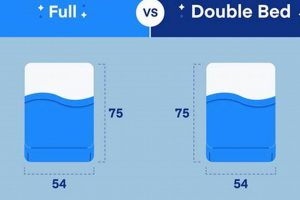
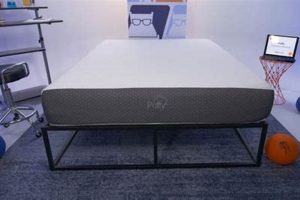
![Choosing Innerspring vs Memory Foam Mattress? [Guide] Organic & Natural Mattress Buyer’s Guide: Non-Toxic Sleep Solutions Choosing Innerspring vs Memory Foam Mattress? [Guide] | Organic & Natural Mattress Buyer’s Guide: Non-Toxic Sleep Solutions](https://mattressworldpa.com/wp-content/uploads/2025/07/th-1100-300x200.jpg)
